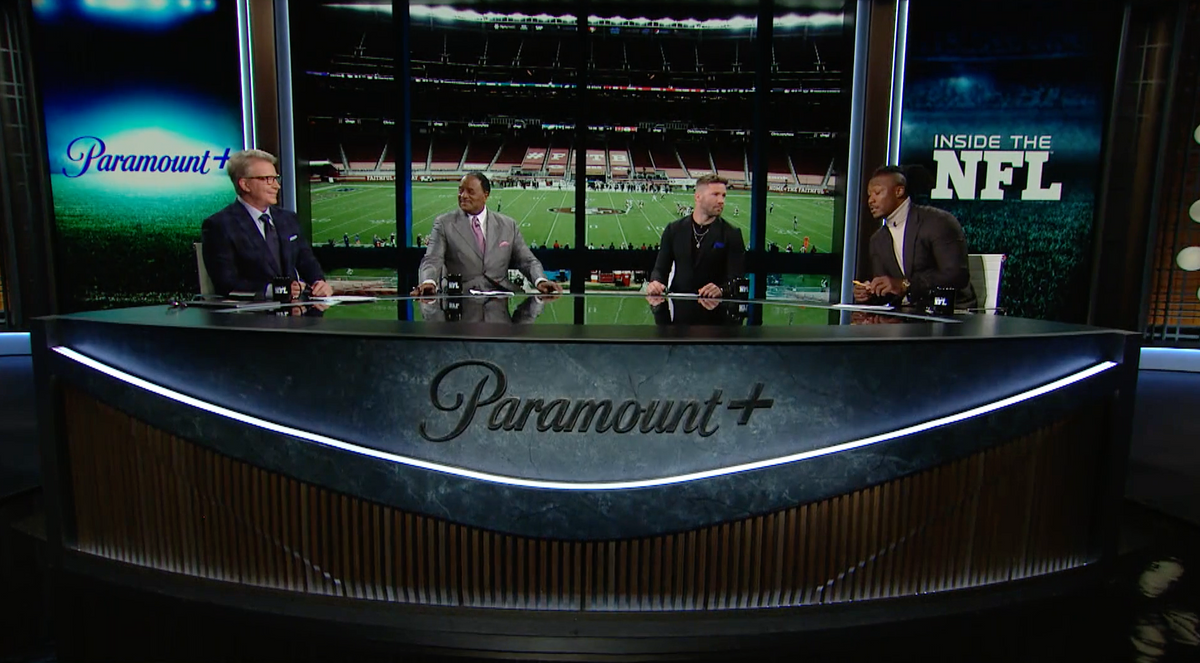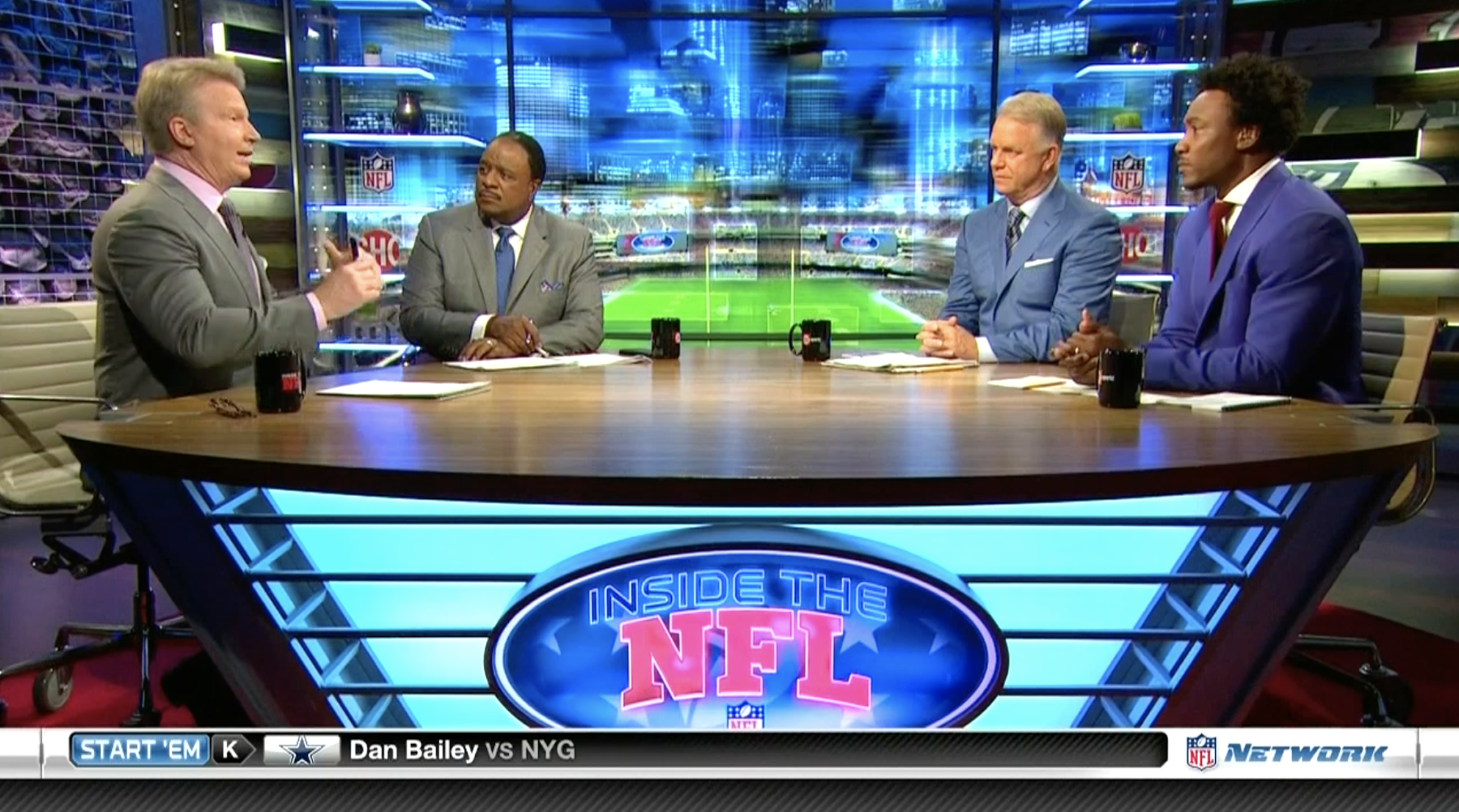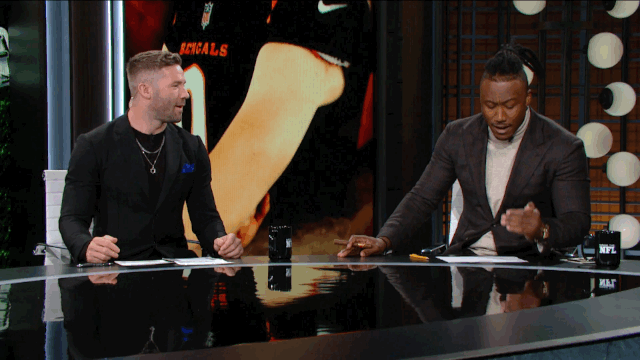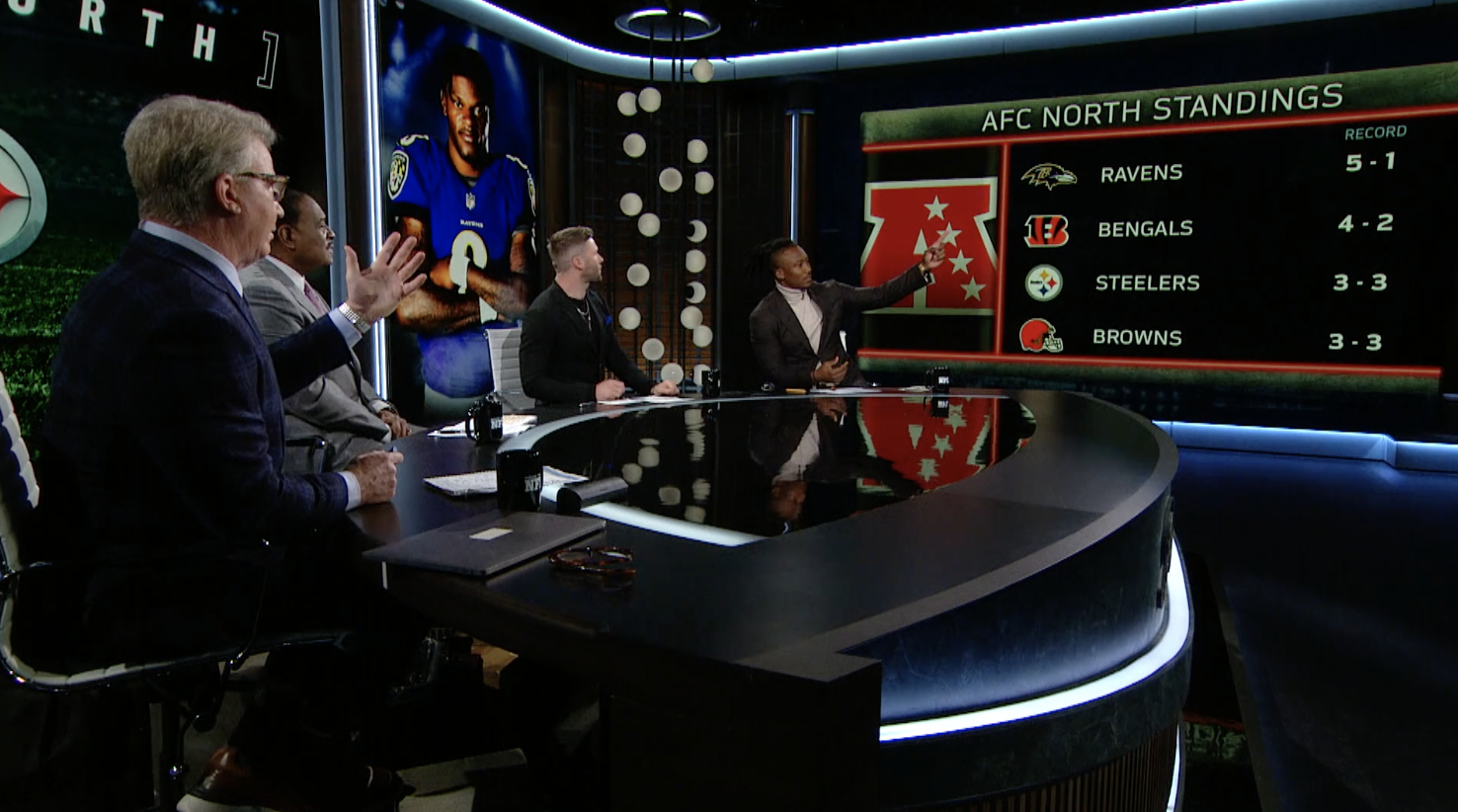How "Inside The NFL" finds the NFL's inner peace

Doink-O-Rama is John Teti’s column about pro football.
Inside Inside The NFL
There is a quaintness to Inside The NFL, the long-running chat-and-highlights show that is now in its 44th season. The title makes an antique promise to pull back the curtain on pro football’s remote inner workings, a promise that hearkens to the series’ origins in the NFL world of the late ’70s. Then, a fan’s experience of the game would typically be limited to the contest itself, highlights on the evening news, and a writeup in the newspaper. It was conceivable that going “inside the NFL” was something special, the sort of premium experience that the young HBO network—home of Inside The NFL for its first three decades—could use to sell HBO programming as something more special than regular TV.

The original creators of Inside The NFL did not conceive a world where pro football has its own TV network, and that network has a football morning show that broadcasts live for three hours, six days a week—even during the offseason, when no football is taking place—and the morning show has a podcast, and people half-pay-attention to all of these things while swiping their thumb across an infinite rectangle of football words and images. “Inside the NFL”? The football media-plex of the 21st century pulls fans in a cocoon where, the league hopes, they struggle to remember a world outside the NFL.
Inside The NFL has changed remarkably little to accommodate these tectonic shifts in sports media generally and NFL media specifically. To be sure, the feel of the show has evolved over 40-odd years—it’s friendlier and more familiar, less newsy than it used to be—but the basic structure remains the same as ever: Leisurely discussions about the state of the season are interspersed with lavish, cinematic highlight packages produced by NFL Films. (For the last decade or so, in fact, the whole show has essentially been produced by NFL Films.)
With this approach, the show has maintained its appeal in a peculiar way. In 2021, the 24-hour firehose of football infotainment makes it impossible to interpret the “Inside” of the show's title as a pledge to provide an insider view you can’t get elsewhere. Instead, I read “Inside” more in the sense of an inner sanctum, a bubble of relative quiet insulated from the sport’s hyperactive noise. The show doesn’t promise to give you more, it promises to give you less, a thoughtfully curated less, presented with a calm and elegance that other football shows lack.
Now I’ll make one of my usual disclaimers that when I use a word like “elegance,” I’m writing in terms relative to the world of pro football. This is not the Coco Chanel spring fashion show. It is a program where meatheads discuss football, a game of people smashing their bodies into each other again and again until a clock runs out. But that’s just it. Inside The NFL strives to be a sophisticated production in an unsophisticated milieu. I think the show’s producers manage the feat, or so I concluded after revisiting the show this week for its latest installment—season 44, episode 7 of Inside The NFL.
The production design

As alert readers may have ascertained from the above screenshot, season 44 of Inside The NFL appears on the streaming service Paramount Plus+. Yes, it’s true. In a long-ago era, this production was the crown jewel of an up-and-coming HBO Sports. But now, Inside The NFL is merely one more hodge in the hodgepodge of entertainment that was hastily podged together to create Paramount Plus+, America’s least-beloved streaming service.
The laughable prominence of the on-set logo is right in line with the flop-sweat desperation that characterizes the whole of Paramount Plus+, a subscription service whose only programming strategy is to smush together disparate pieces of TV’s bygone glory days, like so many slivers of leftover bar soap, and hope that the resulting lump is worth a damn. It’s Paramount "Plus" because that’s the leap of faith Paramount wants us all to take—the “plus.” In every promo, they keep telling us, you get RuPaul, plus golf, plus Survivor reruns, PLUS Spongebob, PLUS!! a bunch of Star Trek—this all adds up to something, right, America? PLUS+++ FOOTBALL! Is it something yet?
The giant metallic Paramount Plus+ logo, placed front and center on the Inside The NFL desk, on a marble background, with an obscenely vain lighting treatment, is the sort of aesthetic execution that says to me, they are not so sure it all adds up to something. So they make the furniture go out there and talk a big game. This poor desk was destined for a happy life as the flagship desk in the valet parking area of a four-star hotel, until Paramount Plus swooped in: Sorry, bub, you’re actually gonna be a table for dis here football show. Gonna make our network look reeeeal fancy. Gonna make our panelists look reeeeal tiny.

Here’s a wide shot from a 2016 Inside The NFL panel discussion, when the show was on Showtime (although I captured this clip from an NFL Network re-airing). Even though the 2016 season was clearly produced in a smaller studio, the composition is more open and inviting. The figures of our beloved meatheads are more sensibly proportioned relative to the frame—we can see their facial features. The central bloom of light hits the warmth of the desktop and radiates out to the panelists.

Compare that to the central light of the 2021 shot, which slams into that unkind slab of corporate branding—wham! In case you forgot, you’re watching Paramount Plus++++!
Tacky.

I also, however, love the desk, because it looks good from every other angle. It’s so pleasingly shiny on top, and the show uses it effectively. In a medium shot, seen from a steeper angle, the desk creates a watery reflection. This extends the effect of the giant background graphics and adds liveliness to the picture by, for instance, doubling the motion of the panelists as they rant and gesticulate.

In this gorgeous side shot, the shiny desk pulls the spiraling light fixture and the graphic from the background into the middleground of the picture. The other visual drama in the shot is created by the sweep of the panel from Brandon Marshall at the far end to Phil Simms on the near end. A stripe of light on the desk encourages our eye to follow this arc one way or another. The space feels large, but the foreground of the shot also feels quite close—we can see Phil’s shoes, his bits and bobs on the desk. It’s like we’re sitting next to him. Scale and intimacy are two essential, complementary ingredients of TV shot-making, and this shot maximizes both. That takes the coordinated effort of set designers, directors, camera operators—it’s a team effort. It amazes me how great the desk setup looks when it is photographed from anywhere but the front. It convinces me that the creative team has experience and well-developed taste.

We do spend a lot of time in the wide shot, though, staring into the maw of that robotic baleen whale with a Paramount logo on its head. PLUS A ROBOT WHALE! IS IT SOMETHING YET?
The talent

Halfway through the show, a few stagehands wheel the desk off to its underwater home, and they unroll the largest carpet Ikea would sell them. It is time for Inside The NFL to enter lounge mode, a more relaxed environment where we get to observe the football guys in their natural state—just hangin’ out, wearin’ some suits around the old Paramount Plus+ hockey puck.
On this episode, the panelists discuss the matter of “the daily grind,” ostensibly because the season is well underway but the end is nowhere in sight. It’s a thin premise, but the lack of specificity is intentional. It leaves a wide open space for the ex-players to share a range of anecdotes from their playing days, which is the real reason this segment exists—to humanize the game. The highlight packages, with their orchestral scores and slow-motion replays, make the players seem superhuman. A laid-back chat session like this one, examining more prosaic aspects of NFL life, re-humanize them.
Like scale and intimacy in visuals, “superhuman” and “human” are two complementary forces in sports storytelling, each enhancing the other. Every NFL broadcast will offer some of both. The announcers will ooh and ahh over a receiver making an impossible catch, say, and then moments later mention that he missed practice all week because his wife just gave birth. The human details allow us to empathize with the players, to see them as avatars of ourselves, so that when they do extraordinary things, we get a vicarious thrill.

And the human details are a specialty of Inside The NFL. The “daily grind” discussion segment is an opportunity for the show to deliver on the original spirit of “Inside” by illuminating the rarefied experience of playing football at the highest level. None of the players’ insights are especially profound, but the color and authenticity of their little stories adds a thread of relatable humanity to the story of the football season, as when former New England Patriots wide receiver Julian Edelman reflects on the inevitable midseason slump:
You get the rah-rah guys in the first three games, starting the season: “Yeah!” Everyone feels a hundred percent. Everyone’s healthy. [Then] the season’s starting to change. You start getting to work, it’s dark. You start leaving work, it’s dark. Only time you see daylight is at practice. […] This is when it starts to kill guys, mentally. This is when you see the competitive stamina of these young men.
Poor bastards! They never saw the solstice coming.
Edelman, who retired from the Patriots after the 2020 season, is new to Inside The NFL this season, but you can tell he comes to the job with a well-developed feel for the rhetorical rhythms of pro football storytelling. Edelman’s TV persona has the swagger and knowingness of the champion, the Super Bowl MVP who has witnessed firsthand the literal darkness that might bring the lesser athletes—“these young men”—to their knees.

Edelman is one of my favorite athletes, and he’s a perfectly watchable commentator, but as a TV character, I find his castmate Brandon Marshall more compelling. Like Edelman, Marshall was a talented receiver with a long career in the league, but unlike Edelman, Marshall bounced from one losing team to another. When Edelman speaks about the “grind,” his story has an unspoken happy ending, a pervading sense that it was all worth. Brandon Marshall’s grind was more pure.
That’s one of the reasons I ended up playing for six teams. I was at losing organizations. Guys would be out there, they didn’t want to compete, and you’re trying to change that culture. For me, I didn’t know how to communicate that in my younger days, so what I’d do is, I’d end up slapping you upside your helmet. “I’ll give you three warnings! Let’s compete! Let’s compete!”
There is a purity to Marshall in general, a rawness to his love for football, that emerges in the impassioned whines and crackles of his voice as he engages his fellow panelists. Before our eyes he will ride a swell of emotion like a child, and then temper himself with the hard-won maturity of a grown man. More so than your typical football commentator, you feel like you’re getting the whole human being with Brandon Marshall.

My love for Phil Simms is well-documented. The former New York Giants quarterback is often regarded as a big old doofus, but to me, his longevity in the TV business says otherwise. To my eyes, Simms is not so stupid—he has real insights to offer. But he is willing to play the doofus, and his gently bumbling manner makes him well-suited to the role.
Watch Simms any time his castmates make fun of him on Inside The NFL or on CBS’ Sunday studio shows—you won’t have to wait long for it to happen. Simms always takes the “abuse” with a bemused shrug. He has been in the business long enough to know he provides real value as the whipping boy—the jokes and guffaws made at Simms’ supposed expense create that air of fraternal locker-room jocularity that TV producers desire. You could probably find plenty of retired QBs who would offer about a similar perspective on the game itself as Simms does, but you would be hard-pressed to find one who could so reliably generate camaraderie on-screen the way dopey-professor Simms does. That, in my opinion, is why CBS and Inside The NFL have stuck with him so long. He makes people laugh. He makes me laugh! For example, with this pair of anecdotes about successfully being a lazy father and unsuccessfully being a lazy football player:
Your family’s got to be involved in it, too. The people around you. […] My wife—I have three kids. They were all young early in my career, and I never got up once, ever, in the whole year. Didn’t ever do anything for the kids when they were crying. [Mimes his wife patting him on the arm.] “Stay in bed and rest.” She was as competitive as—! One morning, I woke up at home, and I was so sick, I said, “I’m not going to be able to play today.” I couldn’t get out of bed. She goes—excuse me, Diana—“Bullcrap, you’re gonna play!”
I mean, there’s just something funny about a big old football guy apologizing to his wife for telling a story about the time she said “bullcrap.” (Although I bet she didn’t actually say “bullcrap.”)

The linchpin of the whole operation is James Brown, who, like Simms, plays much the same role on Inside The NFL as he does on CBS’ Sunday NFL coverage. Nobody is better at hosting a sports studio show than Brown. I simply love to watch him work, nudging and cajoling a segment into shape in real time. He’s like a conductor who works with athletes instead of musicians. The individual panelists are each primarily concerned with making their own points; as host, Brown has to manage the whole symphony.

During the “daily grind” conversation, Brown knows what each member of his team has to offer, and when they stumble, he artfully gets them on course. Early in the segment, Julian Edelman talks about being forced to do grueling hill runs in midseason practice, but his train of thought drifts, and he never really arrives at the moral of his story. Brown waits patiently and then, when there’s an opening a few minutes later, he circles back and points his finger at Edelman: “But pushing through that grind, you said that made a difference in New England—running that hill when you don’t want to.” Edelman catches the cue and wraps up his story in a nice bow: The hill runs built up the team’s endurance for the do-or-die games yet to come. That is the narrative arc Edelman was there to provide, and Brown made sure he provided it.

Later in the segment, Brown similarly nudges Marshall on track by telling him, “Your drive really impressed me in the green room when you said, if you have a teammate that’s really not pushing you […] that really irked you because—” and there, Brown stops short so Marshall can finish the story, which he does, because Brown railroaded Marshall so narrowly that there was no room for error. Which is exactly how to do it. It’s revealing that Brown, before the show, noted a stray remark that Marshall made in the green room and mentally filed it to make sure the moment could be replayed in front of the cameras. Brown was hosting the discussion panel before the taping even began! Which, again—is exactly how to do it.

At the end of this week’s program, Phil Simms presides over a fluffy segment that he calls “Paparazzi Phil,” which is just Simms sharing a couple of behind-the-scenes photos he took with his phone. Simms sets up his first snapshot by noting that the CBS studio crew had to wake up early on Sunday to cover the game being played in London. “So I want you to see what my man James Brown was doing to get ready for the broadcast,” Simms says by way of a setup. We then see a picture of Brown at the CBS desk, eyes closed, with castmate Bill Cowher pointing and grinning at the old anchor’s apparent slumber.
As his Inside The NFL colleagues howl with laughter, Brown protests that he wasn’t sleeping when Simms took that picture; he was ruminating. “What do you call it? It’s like, psychosomatic, right? You’re thinking through the rundown.” This explanation is met with more manly chuckles and good-natured ribbing from the fellas, but I believe him. A good host enters every tape day, every segment, with a sense of what that chunk of TV time has to accomplish. Once the cameras are on, you balance the desire for spontaneity and surprise against your mental checklist of the points that need to be covered for the show to give viewers a coherent story.
It’s Brown’s ability to strike this balance, with the grace of an experienced broadcaster, that keeps Inside The NFL humming along despite its old age. He provides the gravitas, the patient pacing, the skillful listening, that allows the show to stand apart amid an overwhelming surfeit of NFL media. There are plenty of programs that add to the explosive chaos of pro football. That’s easy. It takes a more careful approach—a thoughtful production team, a relatable cast, a nimble host—to bring out the sport’s inner peace.
Your guaranteed-correct Week 7 picks, as computed by DORPFASTCALC

The football picks featured in Doink-O-Rama are guaranteed to be correct, as they are calculated by an outer-space robot observatory known as the Doink-O-Rama Pro Football Anticipation Satellite and Tip Calculator, or DORPFASTCALC.
In its Week 6 picks, true to its ironclad guarantee, DORPFASTCALC correctly predicted the outcome of eight football contests.
Also in Week 6, there were seven aberrations. What are we blaming this week, team? [A distant shout comes from down the hall at Doink-O-Rama headquarters: “The moon!”] The moon. It’s the moon’s fault this week.
Last week: 8 - 7.
Season to date: 40-35. Science works!
SUNDAY — EARLY GAMES
Carolina Panthers vs. New York Giants (Fox): Carolina 21, New York 18.
New York Jets vs. New England Patriots (CBS): New England 24, New York 14.
Kansas City Chiefs vs. Tennessee Titans (CBS): Kansas City 33, Tennessee 27.
Washington Football Team vs. Green Bay Packers (Fox): Green Bay 31, Washington 20.
Atlanta Falcons vs. Miami Dolphins (Fox): Atlanta 23, Miami 13.
Cincinnati Bengals vs. Baltimore Ravens (CBS): Baltimore 2, Cincinnati 0.
SUNDAY — LATE GAMES
Detroit Lions vs. Los Angeles Rams (Fox): Los Angeles 40, Detroit 22.
Philadelphia Eagles vs. Las Vegas Raiders (Fox): Philadelphia 24, Las Vegas 20.
Houston Texans vs. Arizona Cardinals (CBS): Arizona 38, Houston 17.
Chicago Bears vs. Tampa Bay Buccaneers (CBS): Tampa Bay 27, Chicago 20.
SUNDAY NIGHT FOOTBALL
Indianapolis Colts vs. San Francisco 49ers (NBC): San Francisco 24, Indianapolis 23.
MONDAY NIGHT FOOTBALL
New Orleans Saints vs. Seattle Seahawks (ESPN): Seattle 23, New Orleans 21.
Keep on long snappin'
Doink-O-Rama is a free subscription for the foreseeable future. If you want to help me out, share the column with a friend who might like it.
Reach out with your questions, observations, or doink sightings by emailing: doink at ological dot net.
Thank you for reading. Until next week: Keep on long snappin’.
